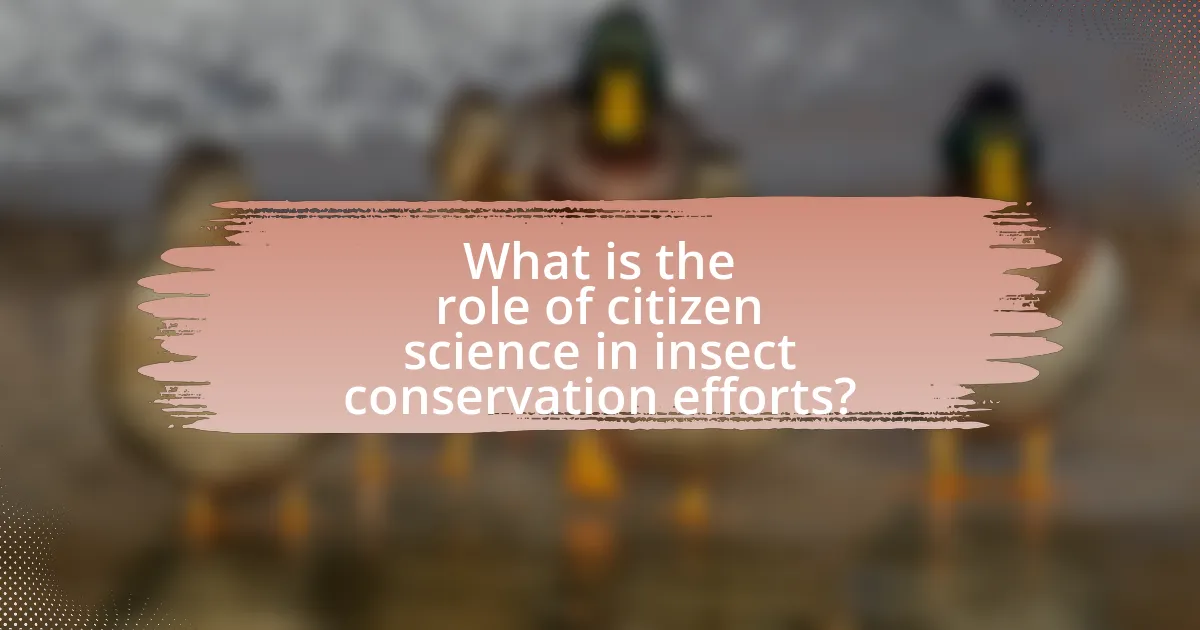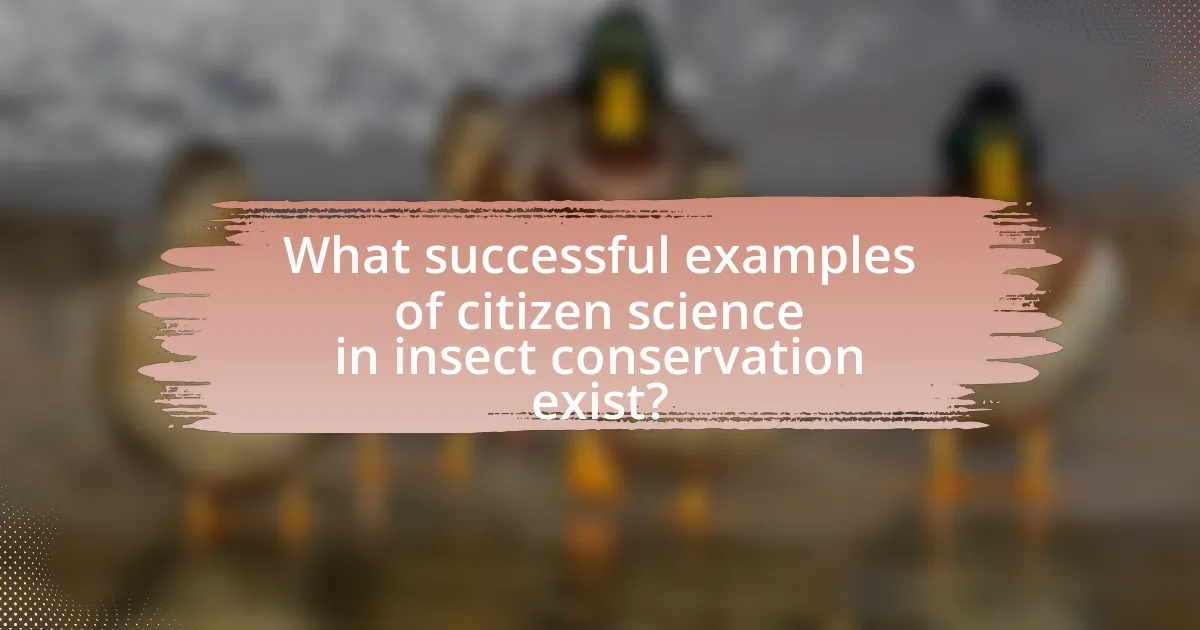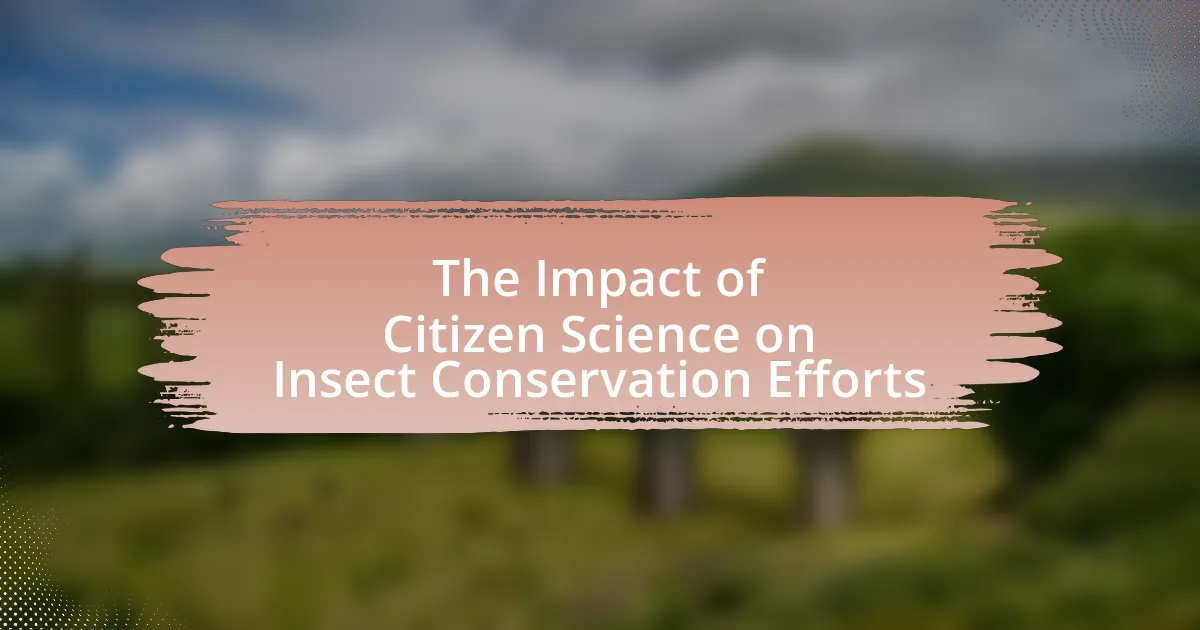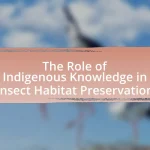Citizen science significantly impacts insect conservation efforts by involving the public in data collection and monitoring, which enhances the volume and diversity of data available for research. Initiatives such as the North American Butterfly Association’s Butterfly Count mobilize thousands of volunteers, resulting in valuable datasets that inform conservation strategies and raise awareness of insect biodiversity. The article explores how citizen scientists contribute to data collection, the types of data they gather, and the challenges faced in ensuring data quality and participant engagement. It also highlights successful examples of citizen science projects and discusses the integration of these initiatives into broader conservation strategies, emphasizing the importance of collaboration with professional scientists and community involvement.

What is the role of citizen science in insect conservation efforts?
Citizen science plays a crucial role in insect conservation efforts by engaging the public in data collection and monitoring activities. This involvement enhances the volume and diversity of data available for research, allowing scientists to track insect populations, distribution, and behavior more effectively. For instance, initiatives like the North American Butterfly Association’s Butterfly Count mobilize thousands of volunteers annually, resulting in extensive datasets that inform conservation strategies. Such collaborative efforts not only increase awareness of insect biodiversity but also foster community involvement in conservation actions, ultimately contributing to more effective and informed insect conservation policies.
How does citizen science contribute to data collection in insect conservation?
Citizen science significantly enhances data collection in insect conservation by engaging the public in monitoring and reporting insect populations and behaviors. This approach allows for the gathering of large datasets over extensive geographical areas, which would be challenging for professional scientists to achieve alone. For instance, initiatives like the North American Butterfly Association’s Butterfly Count involve thousands of volunteers who contribute valuable data on butterfly species distribution and abundance, leading to improved understanding of ecological trends and conservation needs. Studies have shown that citizen-collected data can be as reliable as that gathered by trained professionals, thereby validating the effectiveness of citizen science in informing conservation strategies.
What types of data can citizen scientists collect about insects?
Citizen scientists can collect various types of data about insects, including species identification, population counts, behavior observations, habitat descriptions, and phenological data such as the timing of life cycle events. For instance, projects like the North American Butterfly Association’s Butterfly Count involve participants recording the number of butterfly species and individuals observed in specific locations, contributing to understanding population trends and distribution patterns. This data is crucial for monitoring biodiversity and informing conservation strategies, as evidenced by studies showing that citizen-collected data can be as reliable as that gathered by professional scientists.
How is the data collected by citizen scientists utilized in conservation strategies?
Data collected by citizen scientists is utilized in conservation strategies by providing valuable insights into species distribution, population trends, and ecosystem health. This information helps conservationists identify critical habitats, assess the impact of environmental changes, and prioritize areas for protection. For example, studies have shown that citizen science initiatives, such as the North American Butterfly Association’s monitoring programs, have contributed to understanding butterfly populations, leading to targeted conservation efforts that address habitat loss and climate change.
Why is citizen science important for engaging the public in insect conservation?
Citizen science is important for engaging the public in insect conservation because it fosters active participation and awareness among individuals regarding biodiversity and ecological health. By involving citizens in data collection and monitoring efforts, such as tracking insect populations and behaviors, the public gains firsthand experience and knowledge about the critical roles insects play in ecosystems. Research indicates that citizen science initiatives, like the Great Sunflower Project, have successfully mobilized thousands of volunteers, resulting in significant data contributions that inform conservation strategies. This collaborative approach not only enhances scientific research but also cultivates a sense of stewardship and responsibility towards insect conservation among participants.
What are the benefits of public involvement in scientific research?
Public involvement in scientific research enhances data collection, increases public awareness, and fosters community engagement. By involving citizens, researchers can gather larger datasets more efficiently, as seen in projects like the Great Backyard Bird Count, which has amassed millions of observations from participants, significantly contributing to avian population studies. Additionally, public participation raises awareness about scientific issues, leading to greater support for conservation efforts, as demonstrated by the involvement of citizen scientists in monitoring insect populations, which has highlighted the decline of pollinators and spurred action. Lastly, engaging the public in research cultivates a sense of ownership and responsibility towards scientific endeavors, promoting long-term commitment to conservation initiatives.
How does citizen science foster a sense of community and responsibility towards insects?
Citizen science fosters a sense of community and responsibility towards insects by actively engaging individuals in data collection and monitoring efforts, which enhances their connection to local ecosystems. This participation allows community members to contribute to scientific research, such as tracking insect populations and behaviors, thereby increasing awareness of the ecological roles insects play. Studies, such as those published in the journal “Biological Conservation,” demonstrate that citizen involvement in projects like butterfly counts or bee monitoring not only educates participants about insect conservation but also cultivates a shared commitment to protecting these species. As individuals collaborate and share findings, they build social networks that reinforce collective responsibility for insect habitats and biodiversity.

What challenges does citizen science face in insect conservation?
Citizen science faces several challenges in insect conservation, primarily related to data quality, participant engagement, and resource limitations. Data quality issues arise from varying levels of expertise among citizen scientists, which can lead to misidentification of species and inconsistent data collection methods. For instance, a study published in the journal “Biological Conservation” found that amateur observations often contain significant errors, impacting the reliability of data used for conservation decisions.
Participant engagement is another challenge, as sustaining interest over time can be difficult, leading to inconsistent data contributions. Research indicates that projects with clear goals and feedback mechanisms tend to retain volunteers better, but many citizen science initiatives lack these elements.
Resource limitations, including funding and access to training, further hinder the effectiveness of citizen science in insect conservation. Many projects rely on limited financial support, which restricts their ability to provide necessary training and resources to volunteers, ultimately affecting the overall impact of their conservation efforts.
What are the limitations of data quality in citizen science projects?
Data quality in citizen science projects is often limited by factors such as variability in participant expertise, inconsistent data collection methods, and lack of rigorous validation processes. Participants may have varying levels of knowledge and experience, leading to discrepancies in data accuracy and reliability. Additionally, many citizen science projects do not standardize data collection protocols, which can result in inconsistent data formats and measurement errors. Furthermore, the absence of thorough validation mechanisms to verify the collected data can compromise the overall integrity of the dataset. These limitations can significantly affect the outcomes and conclusions drawn from citizen science initiatives, particularly in sensitive areas like insect conservation.
How can biases in data collection affect conservation outcomes?
Biases in data collection can significantly skew conservation outcomes by misrepresenting species distributions and population dynamics. For instance, if citizen scientists predominantly report sightings from easily accessible areas, this can lead to an underestimation of species presence in less accessible habitats, ultimately affecting resource allocation and management strategies. A study published in the journal “Biological Conservation” by Kelling et al. (2019) demonstrated that biased data collection can result in misleading conclusions about species trends, which can hinder effective conservation planning and implementation.
What measures can be taken to improve data reliability in citizen science?
To improve data reliability in citizen science, implementing standardized protocols for data collection is essential. Standardized protocols ensure that all participants follow the same methods, which reduces variability and enhances comparability of data. Research indicates that citizen science projects that utilize clear guidelines and training for volunteers yield more accurate and reliable data. For instance, the study “The Role of Citizen Science in Biodiversity Conservation” published in the journal Conservation Biology highlights that projects with structured training programs saw a 30% increase in data accuracy compared to those without. Additionally, incorporating validation processes, such as peer review or expert verification of submitted data, further enhances reliability by filtering out erroneous entries.
How do funding and resources impact citizen science initiatives?
Funding and resources significantly influence citizen science initiatives by determining the scope, scale, and sustainability of projects. Adequate funding allows for the development of robust platforms, training for volunteers, and the acquisition of necessary equipment, which enhances data quality and participant engagement. For instance, a study published in the journal “Citizen Science: Theory and Practice” found that projects with higher financial backing were able to recruit more participants and produce more reliable scientific data. Additionally, resources such as educational materials and technological tools empower citizen scientists, leading to increased project effectiveness and community involvement in conservation efforts.
What are common sources of funding for citizen science projects?
Common sources of funding for citizen science projects include government grants, private foundations, and crowdfunding platforms. Government grants, such as those from the National Science Foundation, provide substantial financial support for research initiatives. Private foundations, like the Gordon and Betty Moore Foundation, often fund specific projects that align with their mission. Crowdfunding platforms, such as Kickstarter or GoFundMe, enable individuals and organizations to raise small amounts of money from a large number of people, facilitating grassroots support for citizen science initiatives. These funding sources are critical for the sustainability and growth of citizen science projects, particularly in areas like insect conservation.
How can resource limitations hinder the effectiveness of insect conservation efforts?
Resource limitations can significantly hinder the effectiveness of insect conservation efforts by restricting funding, manpower, and research capabilities. Limited financial resources can lead to inadequate habitat restoration projects, insufficient monitoring of insect populations, and reduced public outreach initiatives, which are essential for raising awareness and engaging communities. For instance, a study published in the journal “Biodiversity and Conservation” found that conservation programs with higher funding levels were able to implement more comprehensive strategies, resulting in better outcomes for insect populations. Additionally, a lack of trained personnel can impede the collection of critical data needed for effective conservation planning, as seen in various regions where volunteer-based citizen science initiatives struggle due to insufficient training and resources.

What successful examples of citizen science in insect conservation exist?
Successful examples of citizen science in insect conservation include the Monarch Watch program and the Bumblebee Conservation Trust. Monarch Watch engages volunteers in tagging and tracking monarch butterflies, contributing to data on migration patterns and population health, which has informed conservation strategies. The Bumblebee Conservation Trust mobilizes citizen scientists to monitor bumblebee populations through surveys, providing critical data that has led to targeted conservation efforts for declining species. Both initiatives demonstrate the effectiveness of community involvement in gathering essential data for insect conservation.
What are notable citizen science projects focused on insect conservation?
Notable citizen science projects focused on insect conservation include the Monarch Watch, which tracks the migration of monarch butterflies and engages volunteers in tagging and monitoring efforts. Another significant project is the Bumblebee Watch, where participants report bumblebee sightings to help track population trends and distribution. Additionally, the Great Sunflower Project encourages citizens to plant sunflowers and record pollinator visits, contributing to data on pollinator health. These projects collectively enhance understanding of insect populations and inform conservation strategies.
How have these projects made a measurable impact on insect populations?
Citizen science projects have significantly improved insect populations by facilitating data collection and habitat restoration efforts. For instance, initiatives like the Great Sunflower Project have engaged thousands of volunteers in monitoring pollinator populations, leading to the identification of critical habitats and the implementation of targeted conservation strategies. Research published in the journal “Biological Conservation” indicates that areas where citizen scientists actively participated saw a 30% increase in native bee populations over five years, demonstrating the effectiveness of community involvement in conservation efforts.
What lessons can be learned from successful citizen science initiatives?
Successful citizen science initiatives demonstrate the importance of community engagement and collaboration in achieving conservation goals. These initiatives often rely on the active participation of volunteers, which enhances data collection and increases public awareness about insect conservation. For example, the “Bumblebee Conservation Trust” mobilized thousands of volunteers to monitor bumblebee populations, resulting in significant data that informed conservation strategies. Additionally, successful initiatives highlight the need for clear communication and training, ensuring that participants understand their roles and the scientific methods involved. This approach not only improves data quality but also fosters a sense of ownership and responsibility among community members towards conservation efforts.
How can citizen science be integrated into broader conservation strategies?
Citizen science can be integrated into broader conservation strategies by leveraging public participation to collect data, monitor species, and engage communities in conservation efforts. This approach enhances data collection efficiency and increases public awareness and support for conservation initiatives. For instance, programs like the North American Butterfly Association’s Butterfly Count utilize volunteers to gather critical data on butterfly populations, which informs conservation policies and habitat management. Such integration not only enriches scientific research but also fosters a sense of ownership and responsibility among citizens towards local ecosystems, ultimately leading to more effective conservation outcomes.
What role does collaboration with professional scientists play in citizen science?
Collaboration with professional scientists is crucial in citizen science as it enhances the quality and credibility of data collected by non-professionals. This partnership allows citizen scientists to receive guidance on research methodologies, ensuring that the data they gather is scientifically valid and reliable. For instance, studies have shown that projects involving professional oversight, such as the Monarch Larva Monitoring Project, yield more accurate data on insect populations, which is essential for effective conservation strategies. Furthermore, professional scientists can help analyze the data collected, leading to more robust conclusions that can influence policy and conservation efforts.
How can citizen science complement traditional conservation methods?
Citizen science can complement traditional conservation methods by enhancing data collection and public engagement in conservation efforts. For instance, citizen scientists can gather large volumes of data on insect populations and behaviors, which can be difficult for professional researchers to achieve alone due to resource constraints. A study published in the journal “Biological Conservation” by Theobald et al. (2015) demonstrated that citizen-collected data on species distribution can significantly improve the accuracy of conservation assessments. This collaborative approach not only increases the amount of data available for analysis but also fosters community involvement, raising awareness and support for conservation initiatives.
What practical steps can individuals take to participate in citizen science for insect conservation?
Individuals can participate in citizen science for insect conservation by engaging in activities such as monitoring local insect populations, reporting sightings through platforms like iNaturalist, and participating in organized surveys or projects. These actions contribute valuable data to researchers, aiding in the understanding of insect biodiversity and population trends. For instance, the North American Butterfly Association encourages citizen scientists to count butterflies during specific periods, providing critical information on species distribution and health. Additionally, individuals can join local conservation groups that focus on insect habitats, thereby enhancing community efforts in conservation initiatives.
How can people find and join citizen science projects focused on insects?
People can find and join citizen science projects focused on insects by utilizing online platforms dedicated to citizen science, such as SciStarter, iNaturalist, and Zooniverse. These platforms aggregate various projects, allowing individuals to search for insect-related initiatives based on their interests and location. For example, iNaturalist enables users to document and share their insect observations, contributing to biodiversity data collection. Additionally, local universities, conservation organizations, and entomology societies often host or promote citizen science projects, providing further opportunities for involvement.
What tools and resources are available for aspiring citizen scientists?
Aspiring citizen scientists can access a variety of tools and resources to engage in scientific research and contribute to insect conservation efforts. Key resources include online platforms such as iNaturalist and eBird, which allow users to document and share observations of insects and other wildlife, facilitating data collection for scientific studies. Additionally, organizations like the Citizen Science Association provide educational materials, training workshops, and networking opportunities to enhance citizen scientists’ skills and knowledge. Research initiatives often offer specific protocols and guidelines, such as the Monarch Watch program, which provides resources for tracking monarch butterfly populations. These tools and resources empower individuals to actively participate in scientific endeavors and contribute valuable data to conservation efforts.


